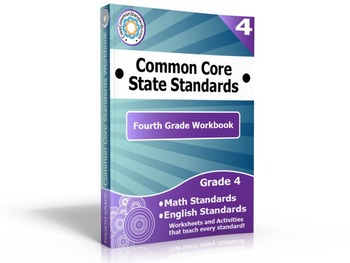Fourth Grade Common Core Workbook
Have Fun Teaching
6.8k Followers
Grade Levels
3rd - 5th, Homeschool, Staff
Subjects
Resource Type
Standards
CCSS4.MD.A.1
CCSS4.MD.A.2
CCSS4.MD.A.3
CCSS4.MD.B.4
CCSS4.MD.C.5
Formats Included
- PDF
Pages
870 pages
Have Fun Teaching
6.8k Followers
Description
This Fourth Grade Common Core Workbook Download is the largest collection of resources for teaching the Common Core State Standards. This workbook includes over 850 pages of Worksheets, Activity Centers, and Posters that teach all the Fourth Grade English and Math Common Core Standards!
NOTE: This is a WORKBOOK DOWNLOAD. Order the Physical Workbook - Click Here
Be sure to download the Free Sample to view some of the resources included in this workbook. Copy and paste this link in your browser: http://corecommonstandards.com/core-standards/fourth-grade-common-core-workbook-sample.pdf
This workbook is copyright Have Fun Teaching, LLC and is also available on our website: www.CoreCommonStandards.com.
NOTE: This is a WORKBOOK DOWNLOAD. Order the Physical Workbook - Click Here
Be sure to download the Free Sample to view some of the resources included in this workbook. Copy and paste this link in your browser: http://corecommonstandards.com/core-standards/fourth-grade-common-core-workbook-sample.pdf
This workbook is copyright Have Fun Teaching, LLC and is also available on our website: www.CoreCommonStandards.com.
Total Pages
870 pages
Answer Key
Included
Teaching Duration
N/A
Last updated Nov 18th, 2013
Report this resource to TPT
Reported resources will be reviewed by our team. Report this resource to let us know if this resource violates TPT’s content guidelines.
Standards
to see state-specific standards (only available in the US).
CCSS4.MD.A.1
Know relative sizes of measurement units within one system of units including km, m, cm; kg, g; lb, oz.; l, ml; hr, min, sec. Within a single system of measurement, express measurements in a larger unit in terms of a smaller unit. Record measurement equivalents in a two-column table. For example, know that 1 ft is 12 times as long as 1 in. Express the length of a 4 ft snake as 48 in. Generate a conversion table for feet and inches listing the number pairs (1, 12), (2, 24), (3, 36),...
CCSS4.MD.A.2
Use the four operations to solve word problems involving distances, intervals of time, liquid volumes, masses of objects, and money, including problems involving simple fractions or decimals, and problems that require expressing measurements given in a larger unit in terms of a smaller unit. Represent measurement quantities using diagrams such as number line diagrams that feature a measurement scale.
CCSS4.MD.A.3
Apply the area and perimeter formulas for rectangles in real world and mathematical problems. For example, find the width of a rectangular room given the area of the flooring and the length, by viewing the area formula as a multiplication equation with an unknown factor.
CCSS4.MD.B.4
Make a line plot to display a data set of measurements in fractions of a unit (1/2, 1/4, 1/8). Solve problems involving addition and subtraction of fractions by using information presented in line plots. For example, from a line plot find and interpret the difference in length between the longest and shortest specimens in an insect collection.
CCSS4.MD.C.5
Recognize angles as geometric shapes that are formed wherever two rays share a common endpoint, and understand concepts of angle measurement:





